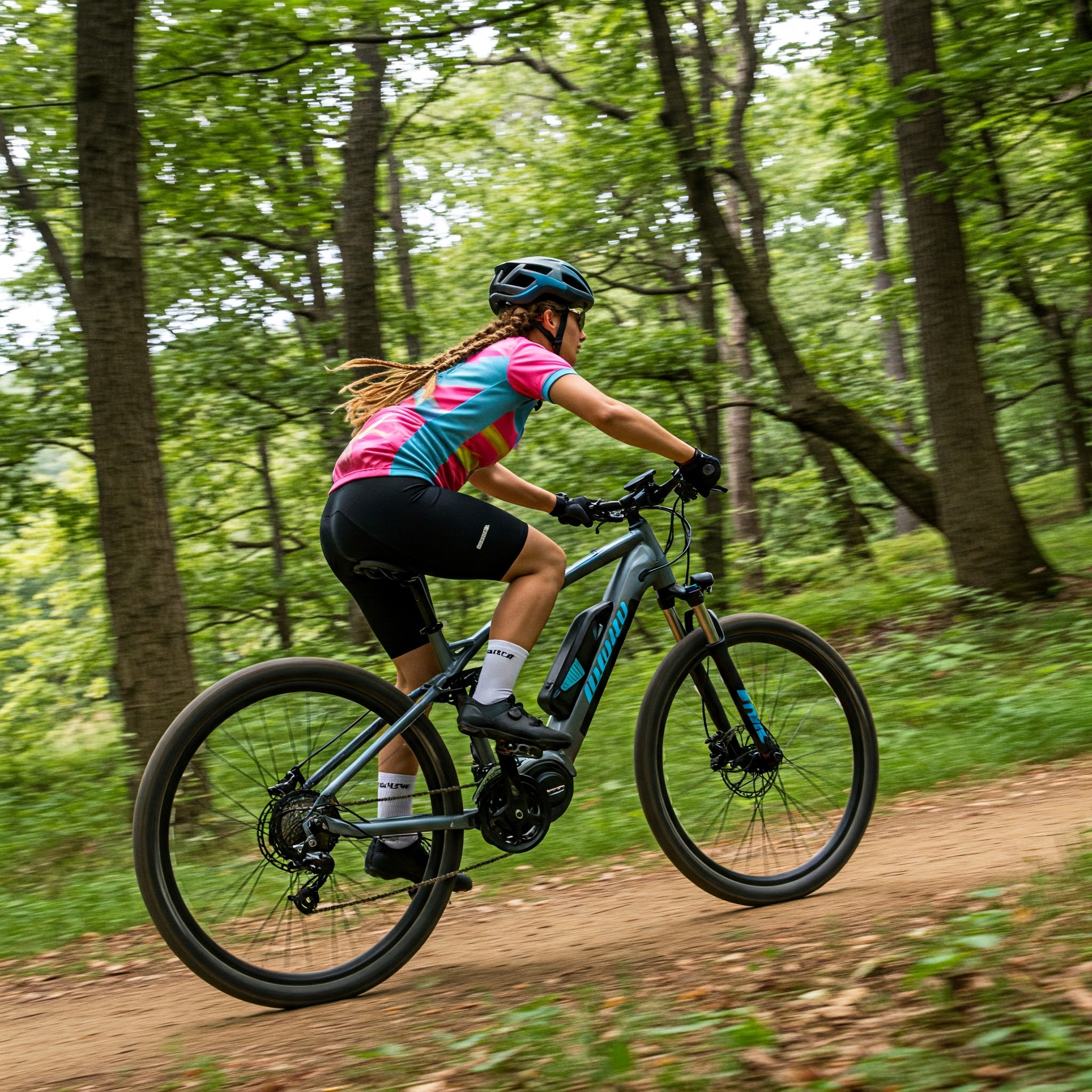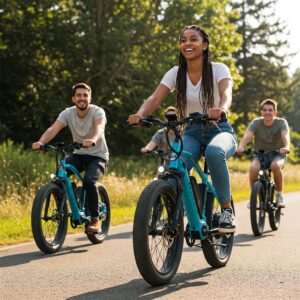The Power Revolution on Two Wheels ⚡
Have you ever found yourself stuck in traffic, watching cyclists zip past while you’re barely moving? I certainly have, and that frustration led me to discover the game-changing world of 1000w ebikes. These powerful electric bicycles are not your average pedal-assist rides – they’re legitimate transportation alternatives that are reshaping how Americans move through urban environments.
A 1000w ebike represents the sweet spot in electric bicycle performance, offering substantial power without crossing into motorcycle territory. With rising gas prices and increasing environmental concerns, these high-performance electric bicycles provide a compelling alternative for commuters, adventure seekers, and practical riders alike.
In this comprehensive guide, I’ll walk you through everything you need to know about 1000w ebikes – from their impressive capabilities to the legalities of riding one in your neighborhood. Whether you’re contemplating your first electric bicycle purchase or looking to upgrade to something with more muscle, you’re in the right place to power up your knowledge.
What Exactly Is a 1000w Ebike? 🔋
Before diving deeper, let’s clarify what we mean by a “1000w ebike.” The “1000w” refers to the wattage of the electric motor, which indicates its power output. Compared to standard ebikes that typically range from 250w to 750w, a 1000w ebike offers significantly more power and capability.
Think of wattage as the horsepower of your electric bicycle – the higher the number, the more powerful the performance. A 1000w ebike can:
✅ Achieve higher top speeds (typically 28-35 mph depending on regulations)
✅ Climb steeper hills with less effort
✅ Carry heavier loads with ease
✅ Provide stronger acceleration
✅ Handle more challenging terrain than lower-wattage models
The 1000w classification puts these ebikes in a performance category that bridges the gap between standard electric bicycles and light electric motorcycles. This power rating represents the peak output the motor can achieve, though sustained power might be somewhat lower during typical riding conditions.
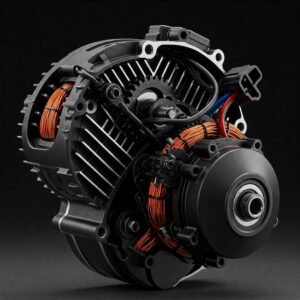
The Compelling Benefits of Owning a 1000w Ebike 🚴♂️
1. Unmatched Speed and Performance
The most immediate benefit you’ll notice with a 1000w ebike is the impressive speed and acceleration. While many standard ebikes top out around 20 mph, a 1000w model can reach speeds of 28-35 mph depending on the specific build and local regulations. This speed advantage significantly reduces commute times and makes longer trips more feasible without a car.
I recently timed my cross-town commute on both a standard 500w ebike and a 1000w model. The difference was remarkable – my 8-mile journey took just 22 minutes on the 1000w ebike compared to 32 minutes on the 500w model. That time savings adds up quickly over weeks and months of commuting.
2. Superior Hill-Climbing Ability ⛰️
If you live in a hilly area, you’ll particularly appreciate the hill-climbing prowess of a 1000w ebike. These powerful motors make quick work of inclines that would leave riders of standard ebikes struggling or dismounting to walk.
During a recent test ride through San Francisco’s notorious hills, my 1000w ebike maintained a comfortable 15 mph up a 12% grade – an impressive feat that would be nearly impossible on a conventional bicycle and challenging even for many lower-powered ebikes.
3. Extended Range Possibilities
While motor wattage doesn’t directly determine range (battery capacity plays a bigger role there), the efficiency of a 1000w motor when used judiciously can actually extend your riding range. How? The additional power allows you to:
✅ Maintain higher speeds with less effort
✅ Use pedal assist more strategically
✅ Navigate challenging terrain more efficiently
Many quality 1000w ebikes can achieve ranges of 40-60 miles on a single charge when using a combination of pedal assist and throttle control, making them practical for longer commutes and day trips.
4. Improved Cargo Capacity
The extra power of a 1000w motor makes these ebikes excellent for cargo hauling. Whether you’re picking up groceries, carrying work equipment, or even transporting a child seat, the additional wattage ensures you won’t struggle under heavier loads.
I regularly use my 1000w ebike for grocery runs, easily carrying two full bags of shopping without noticing any significant performance impact – something that would definitely strain a lower-powered ebike.
5. Reduced Vehicle Dependency 🚗
Perhaps the most significant benefit for many riders is the ability to replace car trips more effectively. With the speed, range, and cargo capacity of a 1000w ebike, you can realistically handle most urban transportation needs without reaching for the car keys.
This reduction in car usage translates to:
✅ Significant cost savings on gas, parking, and vehicle maintenance
✅ Reduced carbon footprint
✅ Less time spent in traffic
✅ More enjoyable commuting experiences
✅ Improved physical and mental health
Top 1000w Ebikes Worth Considering in 2025
The market for high-performance electric bicycles has expanded dramatically in recent years. Here are some standout models that deliver exceptional 1000w performance:
For Urban Commuters
Himiway Cobra Pro Electric Mountain Bike stands out with its incredible 1000W motor and robust 48V 20Ah battery. This powerhouse combines rugged performance with practical commuting features, including integrated lights and a comfortable upright riding position that’s perfect for navigating city streets.
For Off-Road Adventures
The Ariel Rider Grizzly Dual Motor Electric Bike delivers an astonishing combined 2000w of power (dual 1000w motors) for unmatched off-road capability. With fat tires, dual suspension, and incredible climbing ability, it’s the ultimate weekend warrior for trail enthusiasts who want maximum power in challenging terrain.
For Versatile All-Rounders
The QuietKat Apex Pro Electric Mountain Bike offers 1000w of refined performance in a versatile package that transitions seamlessly between commuting and weekend adventures. Its mid-drive motor placement provides better weight distribution and a more natural riding feel compared to hub-motor alternatives.
Comparison: 1000w Ebikes vs. Lower-Powered Alternatives
To help you understand how 1000w ebikes stack up against their lower-powered counterparts, here’s a quick comparison table:
| Feature | 250-350w Ebike | 500-750w Ebike | 1000w Ebike |
|---|---|---|---|
| Top Speed | 15-20 mph | 20-28 mph | 28-35 mph |
| Hill Climbing | Moderate | Good | Excellent |
| Range | 20-40 miles | 30-50 miles | 40-60 miles |
| Cargo Capacity | Limited | Good | Excellent |
| Cost Range | $800-1,500 | $1,500-3,000 | $2,000-5,000 |
| Weight | 45-55 lbs | 50-65 lbs | 60-80 lbs |
| Best For | Casual riders | Regular commuters | Power users |
Ready to experience the transformative power of a high-performance electric bicycle? Check out these top-rated 1000w ebikes now – your commute will never be the same!

Understanding the Legal Landscape 📜
Before investing in a 1000w ebike, it’s crucial to understand the legal considerations. In the United States, electric bicycle regulations vary significantly by state and sometimes even by city or county.
Federal Classification
At the federal level, the Consumer Product Safety Commission (CPSC) defines an electric bicycle as having:
- A motor of less than 750w
- A top speed of less than 20 mph on motor power alone
- Functional pedals
This means that technically, a 1000w ebike exceeds federal classification as an “electric bicycle” and might be classified differently in some jurisdictions.
State Variations
Many states have adopted the three-class ebike system:
- Class 1: Pedal-assist only (no throttle), maximum assisted speed of 20 mph
- Class 2: Throttle-assisted, maximum speed of 20 mph
- Class 3: Pedal-assist only, maximum assisted speed of 28 mph
A 1000w ebike typically falls outside these classifications or would be limited to operate within these parameters despite its greater capability.
States like California, Colorado, and New York have clear regulations allowing Class 3 ebikes on most roads but prohibiting them on some paths. Other states have more restrictive or sometimes more permissive approaches.
Practical Considerations
In practice, many 1000w ebikes are sold with programmable settings that allow you to limit the power output and top speed to comply with local regulations. Some manufacturers also offer “off-road only” designations for their more powerful models.
I strongly recommend:
- Researching your specific state and local regulations
- Considering where you’ll primarily ride
- Understanding potential insurance implications
- Always prioritizing safety with appropriate gear and responsible riding
Battery Technology and Range Factors 🔌
The battery is arguably the most critical component of any ebike, and this is especially true for power-hungry 1000w models. Let’s explore what you should know about battery technology for these high-performance machines.
Battery Specifications to Consider
When evaluating a 1000w ebike, pay close attention to these battery specs:
- Voltage: Most 1000w ebikes use 48V or 52V batteries. Higher voltage generally means better performance.
- Amp Hours (Ah): This measures capacity. Look for at least 15Ah for decent range with a 1000w motor.
- Watt Hours (Wh): The total energy capacity (Voltage × Amp Hours). A 1000w ebike typically needs at least 700Wh for reasonable range.
- Battery Chemistry: Most use lithium-ion, but the specific formulation matters. Samsung, LG, and Panasonic cells are generally considered high quality.
Realistic Range Expectations
The actual range you’ll get from a 1000w ebike depends on numerous factors:
✅ Rider weight
✅ Terrain (hills dramatically reduce range)
✅ Pedal assist level used
✅ Throttle usage (heavy throttle use consumes battery faster)
✅ Weather conditions (cold weather reduces battery efficiency)
✅ Tire pressure and type
✅ Age of the battery
As a general guideline, expect:
- 20-30 miles with heavy throttle use
- 40-60 miles with moderate pedal assist
- 60+ miles with minimal assist on flat terrain
The Engwe Engine Pro Electric Bike offers excellent battery life with its 48V 16Ah battery that can deliver up to 60 miles of range when used efficiently. This makes it an excellent choice for riders concerned about range anxiety.
Battery Maintenance Tips
To maximize the lifespan of your expensive 1000w ebike battery:
- Avoid regularly depleting below 20% charge
- Avoid leaving fully charged for extended periods
- Store in cool, dry conditions if not using for weeks or months
- Follow manufacturer’s specific charging instructions
- Consider purchasing a smart charger that prevents overcharging
Motor Types and Their Impact on Performance 🔧
Not all 1000w ebike motors are created equal. The type of motor significantly affects the riding experience, maintenance requirements, and overall performance.
Hub Motors vs. Mid-Drive Motors
Hub Motors
Most affordable 1000w ebikes use hub motors, which are integrated into either the front or (more commonly) rear wheel.
Advantages:
- Generally less expensive
- Simpler maintenance (fewer moving parts)
- Direct power delivery
- Can often use throttle even from standstill
Disadvantages:
- Weight distribution is concentrated in the wheel
- Less efficient on hills
- Cannot leverage bicycle gears for efficiency
- More challenging wheel removal for maintenance
Mid-Drive Motors
Higher-end 1000w ebikes often feature mid-drive motors positioned at the crank.
Advantages:
- Better weight distribution
- Can leverage bicycle gears for efficiency
- More natural riding feel
- Better hill climbing efficiency
- Less strain on spokes and wheel components
Disadvantages:
- Usually more expensive
- More complex maintenance
- More wear on drivetrain components
The Rambo Rebel 1000w XPS uses a sophisticated mid-drive motor system that provides exceptional torque for climbing and better overall efficiency than most hub-motor alternatives.
Direct Drive vs. Geared Hub Motors
For hub motors, you’ll encounter two main types:
- Direct Drive: Larger, heavier, and can offer regenerative braking, but generally less efficient at low speeds
- Geared Hub: Smaller, lighter, more efficient at low speeds, but typically cannot offer regenerative braking
For a 1000w setup, direct drive motors are more common as they handle higher power levels more effectively.
Essential Accessories for 1000w Ebike Owners 🧰
The power and speed of a 1000w ebike mean you should consider specific accessories to maximize safety, utility, and enjoyment:
Safety First
- High-Quality Helmet: At speeds potentially reaching 30+ mph, a bicycle helmet may not be sufficient. Consider a full-face mountain biking helmet or even a motorcycle helmet for maximum protection.
- Enhanced Lighting: Factory lights on many ebikes are inadequate for the speeds achieved on 1000w models. Invest in:
- A powerful headlight (1000+ lumens)
- Bright tail lights (preferably with brake light functionality)
- Side visibility lights
- Rearview Mirrors: Essential for maintaining awareness at higher speeds without constantly turning your head.
Practical Additions
- Upgraded Lock System: The higher value of 1000w ebikes makes them prime targets for theft. Consider:
- Heavy-duty U-lock
- Secondary cable lock
- GPS tracker
- Suspension Upgrades: The higher speeds make quality suspension more important:
- Front suspension fork with adequate travel
- Suspension seatpost for hardtail models
- Consider full-suspension models for serious riders
- Puncture-Resistant Tires: Flat tires at high speeds can be dangerous. The Schwalbe Marathon Plus Tires offer exceptional puncture protection while maintaining good performance characteristics.
Comfort and Convenience
- Phone Mount: For navigation and ride tracking.
- Extended Range Battery: For those who want to push their range limits, consider a second battery or extended range options.
- Cargo Solutions: Panniers, frame bags, or a rear rack can maximize the utility of your powerful ebike.
Maintenance Considerations for High-Power Ebikes 🔩
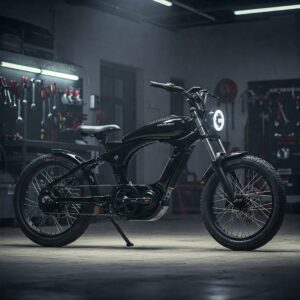
The additional power of a 1000w ebike means certain components experience more stress and wear than on standard bicycles or lower-powered ebikes.
Critical Maintenance Areas
- Brakes: With greater speeds come greater stopping demands.
- Inspect brake pads weekly if commuting daily
- Consider upgrading to hydraulic disc brakes if not already equipped
- Learn basic brake adjustment techniques
- Drivetrain:
- Chain wear happens faster with added power
- Replace chains more frequently than on conventional bikes
- Consider belt-drive options for reduced maintenance
- Tires:
- Check pressure before every ride
- Inspect for wear weekly
- Replace when worn to maintain traction and safety
- Electrical System:
- Keep connections clean and dry
- Periodically check motor mounting bolts for tightness
- Keep battery contacts clean
Professional Service Intervals
Even if you’re handy, professional service is recommended:
- Initial tune-up after 100-200 miles
- Regular service every 500-1000 miles
- Annual comprehensive inspection regardless of mileage
Real User Experiences: 1000w Ebikes in Daily Life 👥
To provide a more rounded perspective, I spoke with several long-term 1000w ebike owners about their experiences. Here are some insights from real riders:
Mark, Urban Commuter (Chicago)
“My 1000w ebike completely replaced my second car. I commute 15 miles each way in all but the worst weather, and the power means I can keep up with traffic flow on all but the largest roads. The savings in parking alone paid for the bike in the first year.”
Jennifer, Weekend Adventurer (Colorado)
“I use my 1000w mountain ebike for trail riding. The power lets me explore twice the distance I could before, and I still get a great workout by using the lower assist levels. On the steepest climbs, I crank it up to full power and can conquer hills that would be impossible otherwise.”
Carlos, Delivery Rider (New York)
“As a food delivery rider, the 1000w motor makes a huge difference when I’m carrying multiple orders up the hills of Manhattan. Battery life was my initial concern, but I found that carrying a second battery lets me work a full 8-hour shift without issues.”
Common Themes
Across all users, several themes emerged:
- Initial concern about the higher price was offset by greater utility
- Range anxiety diminished after gaining experience with the bike
- The ability to keep up with traffic flow increased safety and confidence
- Many underestimated how completely a powerful ebike could replace car trips
Addressing Common Concerns and Misconceptions ❓
When researching 1000w ebikes, you’ll likely encounter several concerns and misconceptions. Let’s address them:
“Aren’t 1000w ebikes illegal?”
Not necessarily, though regulations vary by location. Many 1000w ebikes can be programmed to operate at lower power levels for road use, while utilizing full power off-road or on private property. Check your local regulations.
“The battery won’t last long enough for practical use.”
While battery consumption is higher than on lower-powered models, modern lithium batteries combined with judicious use of assist levels can provide practical ranges of 40+ miles, sufficient for most commuting needs.
“They’re basically just motorcycles.”
Despite their power, 1000w ebikes remain fundamentally different from motorcycles. They’re lighter, often retain the option for human power input, are quieter, and typically have a more bicycle-like riding position and handling characteristics.
“You don’t get any exercise.”
Most 1000w ebikes still allow you to choose your level of exertion. Many riders report getting excellent exercise by using lower assist levels and only utilizing full power for hills or when they need to arrive somewhere without sweating.
“They’re too expensive to be practical.”
While the initial investment is significant, when viewed as a transportation alternative rather than just recreation, the economics become compelling. Compared to car ownership costs, even premium ebikes offer substantial savings over time.
Future Trends in High-Power Electric Bicycles 🔮
The landscape of high-performance ebikes is evolving rapidly. Here are some emerging trends to watch:
Integration and Connectivity
Newer 1000w models are beginning to offer sophisticated integration with smartphones and fitness trackers, providing detailed ride metrics, anti-theft features, and navigation specifically optimized for ebike routes.
Battery Technology Improvements
Expect to see continued improvements in battery energy density, potentially increasing range by 30-50% within the next few years without increasing battery size or weight.
Regulatory Harmonization
As ebikes become more mainstream, expect more standardized regulations across states and countries, potentially creating clearer legal frameworks for higher-powered models.
Sustainable Manufacturing
Look for increased focus on sustainable production methods, recyclable batteries, and lower overall environmental footprints in the next generation of high-performance ebikes.
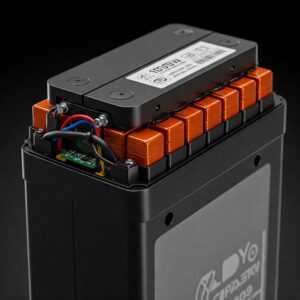
Conclusion: Is a 1000w Ebike Right for You? 🤔
After exploring all aspects of 1000w ebikes, the question remains: is this powerful option the right choice for your specific needs?
A 1000w ebike might be perfect for you if:
- You have challenging hills on your regular routes
- You need to travel distances of 10+ miles regularly
- You want to genuinely replace car trips
- You value higher speeds for commuting efficiency
- You’re a heavier rider who needs more power for assistance
- You frequently carry cargo or passengers
However, you might be better served by a lower-powered option if:
- You primarily ride on flat terrain
- Your trips are typically short
- Legal restrictions in your area limit ebike power
- You’re on a tighter budget
- You prioritize lightweight handling over raw power
Ultimately, a 1000w ebike represents a significant investment in your transportation future. For many riders, myself included, that investment has paid dividends in terms of enjoyment, practical utility, and lifestyle improvement.
The power and versatility of these machines have transformed my daily commute from a stressful drive to an enjoyable ride, saved me thousands in transportation costs, and improved my overall quality of life. If you’re considering making the leap to electric cycling, a 1000w ebike offers a compelling combination of power and practicality that’s hard to beat.
Ready to revolutionize your commute? The powerful 1000w ebikes featured in this guide offer unmatched performance and value. Click through to find your perfect match and experience the liberation of high-performance electric cycling today!
More FQAs:
❓ How fast can a 1000W ebike go?
✅ A 1000W ebike can reach speeds between 28 to 32 mph (45 to 51 km/h), depending on terrain, rider weight, and wind resistance…
❓ What is the range of a 1000W ebike on a single charge?
✅ The range varies based on battery capacity and riding conditions, but most 1000W ebikes can travel between 25 to 50 miles per charge…
❓ Are 1000W ebikes street legal?
✅ Laws vary by location—some areas allow 1000W ebikes on public roads, while others restrict them to off-road use. Always check local regulations…
❓ How long does it take to charge a 1000W ebike battery?
✅ Charging times depend on battery size and charger power, but most 1000W ebike batteries take between 4 to 6 hours to fully charge…
❓ What is the weight limit for a 1000W ebike?
✅ Weight capacity varies by model, but most 1000W ebikes can support riders between 250 to 400 pounds, depending on frame strength and suspension…
Recommended for You:
- Giant Ebike: 7 Powerful Models That Will Transform Your Commute in 2025
- 7 Best Mid Drive Ebike Options That Will Transform Your Cycling Experience in 2025
- Dual Motor Ebike: 7 Powerful Reasons Why They’re Revolutionizing Urban Commuting
Disclaimer: This article contains affiliate links. If you purchase products through these links, we may earn a small commission at no additional cost to you.
